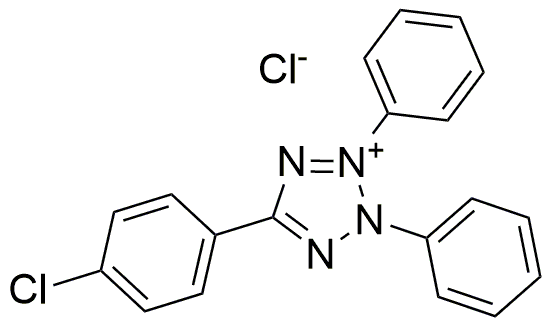2,3-Diphenyl-5-(4-chlorophenyl)tetrazolium chloride is widely utilized in research focused on:
- Cell Viability Assays: This compound is commonly used in laboratories to assess cell viability and proliferation. It helps researchers determine the effects of various treatments on cell health, making it essential in drug development and cancer research.
- Histological Staining: In histology, it serves as a vital stain for identifying living cells in tissue samples. This application is crucial for pathologists and researchers studying tissue morphology and disease progression.
- Electrochemical Sensors: The compound is employed in the development of electrochemical sensors for detecting biological molecules. This application is beneficial in medical diagnostics and environmental monitoring.
- Biochemical Research: It is used in biochemical assays to study enzyme activity and metabolic processes. This aids researchers in understanding cellular functions and developing therapeutic strategies.
- Pharmaceutical Formulations: The compound can be incorporated into pharmaceutical formulations to enhance drug delivery systems, improving the efficacy of medications and patient outcomes.
General Information
Properties
Safety and Regulations
Applications
2,3-Diphenyl-5-(4-chlorophenyl)tetrazolium chloride is widely utilized in research focused on:
- Cell Viability Assays: This compound is commonly used in laboratories to assess cell viability and proliferation. It helps researchers determine the effects of various treatments on cell health, making it essential in drug development and cancer research.
- Histological Staining: In histology, it serves as a vital stain for identifying living cells in tissue samples. This application is crucial for pathologists and researchers studying tissue morphology and disease progression.
- Electrochemical Sensors: The compound is employed in the development of electrochemical sensors for detecting biological molecules. This application is beneficial in medical diagnostics and environmental monitoring.
- Biochemical Research: It is used in biochemical assays to study enzyme activity and metabolic processes. This aids researchers in understanding cellular functions and developing therapeutic strategies.
- Pharmaceutical Formulations: The compound can be incorporated into pharmaceutical formulations to enhance drug delivery systems, improving the efficacy of medications and patient outcomes.
Documents
Safety Data Sheets (SDS)
The SDS provides comprehensive safety information on handling, storage, and disposal of the product.
Product Specification (PS)
The PS provides a comprehensive breakdown of the product’s properties, including chemical composition, physical state, purity, and storage requirements. It also details acceptable quality ranges and the product's intended applications.
Certificates of Analysis (COA)
Search for Certificates of Analysis (COA) by entering the products Lot Number. Lot and Batch Numbers can be found on a product’s label following the words ‘Lot’ or ‘Batch’.
*Catalog Number
*Lot Number
Certificates Of Origin (COO)
This COO confirms the country where the product was manufactured, and also details the materials and components used in it and whether it is derived from natural, synthetic, or other specific sources. This certificate may be required for customs, trade, and regulatory compliance.
*Catalog Number
*Lot Number
Safety Data Sheets (SDS)
The SDS provides comprehensive safety information on handling, storage, and disposal of the product.
DownloadProduct Specification (PS)
The PS provides a comprehensive breakdown of the product’s properties, including chemical composition, physical state, purity, and storage requirements. It also details acceptable quality ranges and the product's intended applications.
DownloadCertificates of Analysis (COA)
Search for Certificates of Analysis (COA) by entering the products Lot Number. Lot and Batch Numbers can be found on a product’s label following the words ‘Lot’ or ‘Batch’.
*Catalog Number
*Lot Number
Certificates Of Origin (COO)
This COO confirms the country where the product was manufactured, and also details the materials and components used in it and whether it is derived from natural, synthetic, or other specific sources. This certificate may be required for customs, trade, and regulatory compliance.


